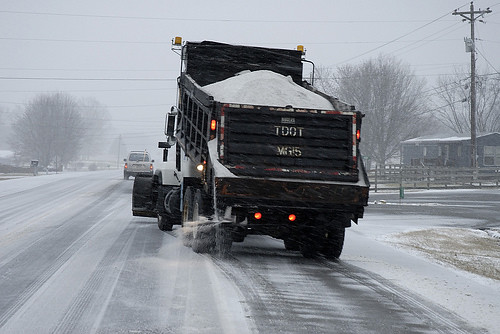Following our weekend snow event earlier this month, it is clear that the problem of salt usage on icy or snowy roads has not been solved.
Management 101 tells us that we must capture data to fully understand this problem. Up until now we have been throwing salt around with only gross estimates available to tell us how much is being used.
Salt costs $58 per ton. It is so cheap that we throw it everywhere; we spread it even in the chance that we might have snow or ice. Unfortunately, salt has many hidden costs:
- It kills fish and vegetation in and along our streams;
- It raises the salt content in our drinking water (bad for folks with high blood pressure or kidney disease);
- It corrodes our bridges and roads ($5 billion in annual repairs);
- It corrodes our pipes (multiple pipes burst each year); and
- It corrodes our cars (multiple muffler shops can attest to this).
At minimum, we need to understand how much salt is being distributed each year. The industry standard is pounds per single–lane mile. In Maryland, no one collects information like this.
If you ask a government jurisdiction, you will get a response such as, “X tons were put down on January 15.” At the city and county level, capturing this data might be as difficult as perhaps using requiring clip boards on each truck distributing salt. And in a state with varied climate zones, this kind of tracking can be more difficult, requiring better organization.
For each winter event, government organizations and private distributors need to be able to accurately report that that X pounds per single lane was distributed in Area Y (e.g., the city of Rockville) in response to a winter storm with Z inches of snow. Without capturing this, it’s impossible to tell whether we are being good stewards of our environment.
We need to be smart when distributing salt. Clearly major roads, dangerous intersections and emergency routes need to be safe. But my flat dead-end street, after the city has brined and plowed my street, does not need additional salt.
There are many ways that we can cut the amount of salt that we are distributing. We could:
- Not salt flat sections of roads that will be naturally dry the next day;
- Not salt empty sections of parking lots;
- Block off low-use roads or parking areas until the snow has melted;
- Not salt every single lane mile (many two-lane roads might only need one lane salted);
- Use more brine or salt alternatives (or mix sand with salt);
- Require salt applicators to track salt usage (see MD Legislation – SB0246 and MD Legislation – HB0371); and
- Provide liability protection to private contractors who distribute salt appropriately.
Improved salt management is one key to fixing this problem. We must know how much salt we are distributing per single-lane mile. Gross estimates—tons used on a specific date—is a crude start, but not enough to compare usage from year to year, whether improvements were made, or not.







Recent Comments